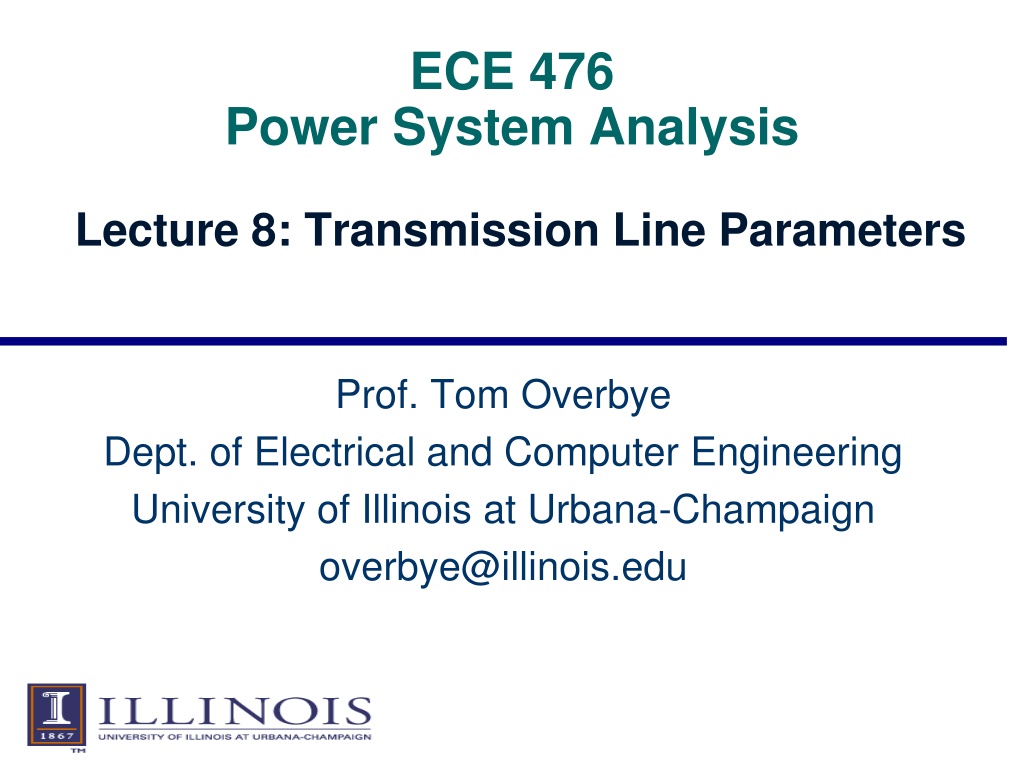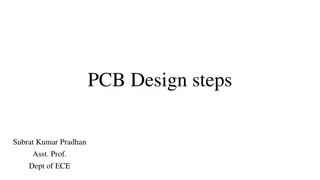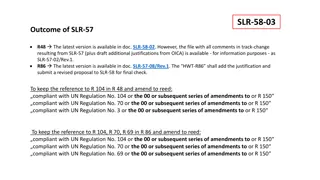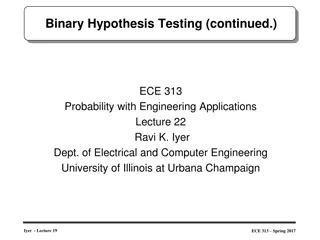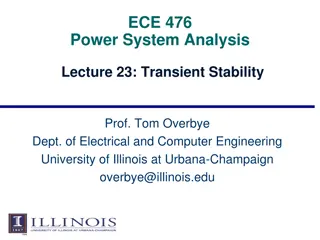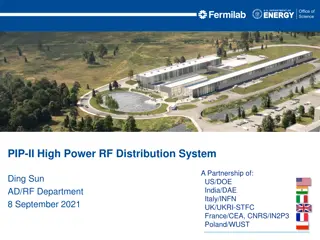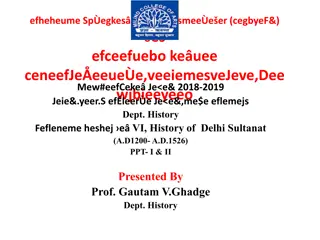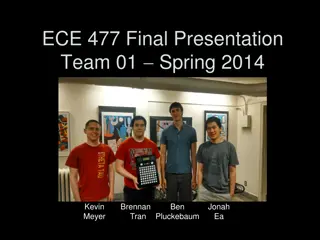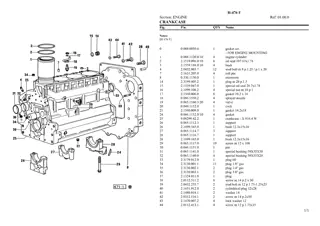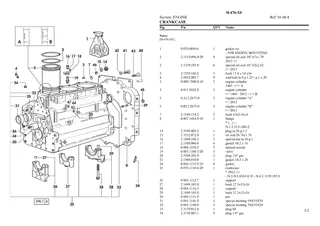ECE 476 Power System Analysis
This lecture delves into the world of transmission line parameters and models, exploring the derivation of V and I relationships, setting up second-order equations, defining propagation constants, and equations for voltage in transmission lines. The content covers the development of models used in power system analysis based on distributed parameters, including inductance, capacitance, and resistance. Through detailed explanations and diagrams, the concept of transmission line equivalent circuits is illuminated, providing a foundational understanding crucial in the field of electrical and power engineering.
Download Presentation

Please find below an Image/Link to download the presentation.
The content on the website is provided AS IS for your information and personal use only. It may not be sold, licensed, or shared on other websites without obtaining consent from the author.If you encounter any issues during the download, it is possible that the publisher has removed the file from their server.
You are allowed to download the files provided on this website for personal or commercial use, subject to the condition that they are used lawfully. All files are the property of their respective owners.
The content on the website is provided AS IS for your information and personal use only. It may not be sold, licensed, or shared on other websites without obtaining consent from the author.
E N D
Presentation Transcript
ECE 476 Power System Analysis Lecture 8: Transmission Line Parameters Prof. Tom Overbye Dept. of Electrical and Computer Engineering University of Illinois at Urbana-Champaign overbye@illinois.edu
Announcements Please read Chapters 5 and 3 Quiz today on HW 3 HW 4 is 4.32, 4.41, 5.1, 5.7, 5.14; this one must be turned in on Sept 22 (hence there will be no quiz that day) 1
Transmission Line Models Previous lectures have covered how to calculate the distributed inductance, capacitance and resistance of transmission lines. In this section we will use these distributed parameters to develop the transmission line models used in power system analysis. 2
Transmission Line Equivalent Circuit Our current model of a transmission line is shown below Units on z and y are per unit length! For operation at frequency , let z = r + j L and y = g +j C (with g usually equal 0) 3
Derivation of V, I Relationships We can then derive the following relationships: dV I z dx dI V dV y dx dV x dI x zI dx = = + ( ) V y dx ( ) ( ) dx = = yV 4
Setting up a Second Order Equation ( ) dx ( ) dx dV x dI x = = zI yV We can rewrite these two, first order differential equations as a single second order equation 2 ( ) ( ) dx d V x dx d V x dx dI x = = z zyV 2 2 ( ) = 0 zyV 2 5
V, I Relationships, contd Define the propagation constant as = = + yz j where = = the attenuation constant the phase constant Use the Laplace Transform to solve. System has a characteristic equation 2 2 = + = ( ) ( )( ) 0 s s s 6
Equation for Voltage The general equation for V is = x x + ( ) V x k e k e 1 2 Which can be rewritten as x x x x + e e e e = + + ( ) ( )( ) ( )( ) V x k k k k 1 2 1 2 2 2 = + = Let K and K . Then k k k k 1 1 2 2 x 1 2 x x x + e e e e = + ( ) ( ) ( ) V x K K 1 2 2 2 ) = + cosh( ) sinh( K x K x 1 2 7
Real Hyperbolic Functions For real x the cosh and sinh functions have the following form: cosh( dx ) sinh( dx ) d x d x = sinh( = cosh( ) ) x x 8
Complex Hyperbolic Functions For x = + j the cosh and sinh functions have the following form = = + + cosh sinh cosh cos sinh cos sinh sin cosh sin x x j j 9
Determining Line Voltage The voltage along the line is determined based upon the current/voltage relationships at the terminals. Assuming we know V and I at one end (say the "receiving end" with V and I where x determine the constants K and K , and hence the voltage at any point on the line. 0) we can R R 1 2 10
Determining Line Voltage, contd = = + ( ) (0) cosh( ) sinh( ) V x V K V x K K x 1 2 = + = cosh(0) sinh(0) K K 1 2 R = = Since cosh(0) ( ) dV x dx 1 & sinh(0) 0 V 1 R = = sinh( + cosh( ) ) zI K x K x 1 2 zI I z yz I Z + z y R R = = = K I 2 R = ( ) cosh( ) sinh( ) V x V x x R R c z y = = where Z characteristic impedance c 11
Determining Line Current By similar reasoning we can determine I(x) V Z = + R ( ) I x cosh( ) sinh( ) I x x R c where x is the distance along the line from the receiving end. out P P = Define transmission efficiency as in 12
Transmission Line Example Assume we have a 765 kV transmission line with a receiving end voltage of 765 kV(line to line), a receiving end power S = + 2000 1000 MVA and j R z = 0.0201 + j0.535 = 0.535 87.8 mile 6 6 y = 7.75 10 = 7.75 10 90 .0 j mile Then = = 88.9 / mile zy 2.036 z y = = 262.7 -1.1 c 13
Transmission Line Example, contd Do per phase analysis, using single phase power and line to neutral voltages. Then 765 441.7 0 kV 3 = = V R * 6 + (2000 3 441.7 0 cosh( 441,700 0 cosh( 443,440 1000) 10 j + = = 1688 26.6 A I R 3 10 = = ( ) ) sinh( 2.036 88.9 ) sinh( x ) V x V x I Z x R R c x + 2.036 88.9 ) 27.7 14
Lossless Transmission Lines For a lossless line the characteristic impedance, Z , is known as the surge impedance. c jwl jwc l c = = (a real value) Z c If a lossless line is terminated in impedance V I I Z V = R = Z c R Then so we get... R c R 16
Lossless Transmission Lines = = + + ( ) ( ) ( ) ( ) I x cosh cosh sinh sinh V x I x V x V I x V x x x R R I R R = Z c 2 V(x) Z Define as the surge impedance load (SIL). c Since the line is lossless this implies ( ) ( ) R I x I = = V x V R If P > SIL then line consumes vars; otherwise line generates vars. 17
Example 5.4 (SIL Loading and Maximum Loading) 2199 MW -0 Mvar 765.0 kV 765.0 kV Reactive Power Losses: 830.4 Mvar slack Angle Difference: -21.4 Deg 2199 0 MW Mvar 18
Transmission Matrix Model Oftentimes we re only interested in the terminal characteristics of the transmission line. Therefore we can model it as a black box . IS IR + + Transmission Line VS VR - - V I V I A C B D S R = With S R 19
Transmission Matrix Model, contd V I V I A C B D S R = With S R Use voltage/current relationships to solve for A,B,C,D cosh S R c R V V l Z I V I I l Z = = = + sinh l = + R cosh sinh l S R c cosh 1sinh c Z sinh l Z l c A C B D T cosh l l 20
Equivalent Circuit Model The common representation is the equivalent circuit Next we ll use the T matrix values to derive the parameters Z' and Y'. 21
Equivalent Circuit Parameters ' V V Y S R = V I R R ' 2 ' ' 2 Z Z Y = + + 1 ' V V Z I S R R ' ' Y Y = + + I V V I S S R R 2 2 ' ' 4 Z Y + ' ' 2 Z Y Z Y = + + + ' 1 1 I Y V I S R R ' ' 2 ' ' 4 1 ' Z V I V I S R = ' ' 2 Z Y Z Y + + S R ' 1 1 Y 22
Equivalent circuit parameters We now need to solve for Z' and Y'. Using the B element solving for Z' is straightforward sinh Then using A we can solve for Y' = = ' B Z l Z C ' ' 2 Z Y = + A = cosh 1 l ' cosh Z 1 l 1tanh c Z Y l l = = 2 sinh 2 c 23
Simplified Parameters These values can be simplified as follows: zl z yl z = = ' sinh sinh Z Z l l C sinh l = = with Z zl (recalling ) Z zy l ' 1tanh c Z Y l yl y zl y l = = tanh 2 2 l 2 tanh Y 2 = with Y yl l 2 2 24
Simplified Parameters For short lines make the following approximations: sinh l = ' (assumes 1) Z Z l ' tanh( /2) Y Y l = (assumes 1) 2 2 /2 l sinh l l tanh( l/2) l/2 Length 50 miles 100 miles 200 miles 0.998 0.02 0.993 0.09 0.972 0.35 1.001 1.004 1.014 0.01 0.04 0.18 25
Medium Length Line Approximations For shorter lines we make the following approximations: sinh l = ' (assumes 1) Z Z l ' tanh( /2) Y Y l = (assumes 1) 2 2 /2 l sinh l l tanh( l/2) l/2 Length 50 miles 100 miles 200 miles 0.998 0.02 0.993 0.09 0.972 0.35 1.001 1.004 1.014 0.01 0.0 0.18 4 26
Three Line Models Long Line Model (longer than 200 miles) l tanh sinh ' l Y Y 2 = = use ' , Z Z l 2 2 l 2 Medium Line Model (between 50 and 200 miles) Y use and 2 use (i.e., assume Y is zero) Z Z Short Line Model (less than 50 miles) 27
Power Transfer in Short Lines Often we'd like to know the maximum power that could be transferred through a short transmission line I1 I1 S21 Transmission Line with Impedance Z = + + V1 S12 V2 - - * V V * 1 2 = S 1 1 V I V 12 1 Z V = = = with , V V V Z Z 1 1 2 2 2 Z 1 2 V V V Z 1 Z 1 2 = + S 12 12 Z Z 28
Power Transfer in Lossless Lines If we assume a line is lossless with impedance jX and are just interested in real power transfer then: 2 V V V Z 1 Z 1 2 + = + 90 90 P jQ 12 12 12 + = Since -cos(90 V V P = ) sin , we get 12 12 1 2 sin 12 12 X Hence the maximu m power transfer is V V X Max 1 2 = P 12 29
